Abstract
This paper presents the conceptual design of an on-axis 6 metre aperture space telescope designed to cover a field of view of ±0.2 degrees with an optical quality at the diffraction limit within a spectral range between 0.5 μm and 2.5 μm. The plate scale is 3 arcsec/mm, and the overall length is less than 12 m. A Korsch layout has been selected based on the superb aberration compensation offered by Three-Mirror Anastigmat systems. The proposed design presents some characteristics: an almost flat response in RMS wavefront error across the field and for the entire spectral range; a flat mirror has been included to reduce the overall volume, and this has been adjusted to be placed at an intermediate pupil position, acting as a baffle for stray light and as a Lyott to restrict background radiation. This mirror presents a central hole, defined to the aperture of the pupil, allowing the transmission of the beam towards the image focal plane, where it can be split for multiple payloads. It also allows the transmission of the central field, at 90 degrees with respect to the science beam, to be used for Active Optics monitoring and correction of the primary mirror in order to ensure optimum optical performance. This on-axis solution significantly reduces the technical complexity for manufacturing, metrology, integration, and tests and has an important impact in the cost of the telescope.
1. Introduction
Most of the scientific cases for current and future space telescopes require large apertures, a wide field of view, and good optical quality. A large aperture offers the possibility to observe fainter objects and provides higher resolution. A wide field of view enables the observation of more objects or a larger region of a specific one. Whilst often it is necessary to choose between one of these two requirements, the combination of these is essential to be able to address the scientific goals of the future space missions. The challenge is how to find a technical solution that provides these characteristics of being lightweight, offering high sensitivity, and contained within a compact volume.
As science evolves towards more ambitious goals, technology faces greater challenges, such as those achieved by the James Webb Space Telescope [1]. The demand for larger telescopes motivated the research on new lightweight materials, segmented mirrors, ways to correct for deformations and misalignment, and deployable solutions. The innovations in this field also imply higher risk and impact the time required for manufacturing, metrology, and tests. Based on these facts, this paper reflects on simplifications in the optical design that lead to less complex solutions. For this purpose, the layout of an on-axis 6 m “Three-Mirror Anastigmat” space telescope is presented, which compensates optical aberrations offering an optical quality at the diffraction limit. The concept of this telescope can be scaled to larger fields and larger apertures. It can also be adapted for different scientific cases and spectral ranges. This proposal is at conceptual design stage. Future work will define tolerances, final material choices, and alignment procedure. The specifications for this space telescope are presented in Section 2.1; the design description and characteristics, in Section 2.2, and the optical performance in Section 2.3. The considerations for the post-focus beam and total volume are discussed in Section 3 and Section 4. Section 6 discusses the advantages of considering an on-axis layout.
2. Optical Design of a 6 m Aperture Space Telescope
2.1. Specifications
The proposed space telescope has an aperture of 6 m. This aperture was defined based on the requirements of the current and next space missions. Table 1 shows some examples of apertures of space missions for different science cases covering different spectral ranges. Planck was the first European space mission to study the Cosmic Microwave Background, covering a range of wavelengths from 300 μm to 11.1 mm, which corresponds to frequencies between 27 GHz and 1 THz. NASA’S Hubble mission [2] has been orbiting the Earth since 1990 observing covering a spectral range from the ultraviolet, visible, and near-infrared. Herschel is an ESA mission with participation from NASA designed to unveil a face of the early Universe previously unknown, with its capability to detect radiation at far infrared and submillimetre wavelengths. The James Webb Space Telescope (JWST) is a NASA mission for infrared astronomy.

Table 1.
Example of apertures for different space telescopes.
The successful development and launch of the James Webb Space Telescope (JWST) proves the feasibility of a 6 m class space telescope. In this manuscript an on-axis layout alternative is proposed for this telescope class.
The field of view is ±0.2 degrees with an optical quality at the diffraction limit within a spectral range between 0.5 μm and 2.5 μm. The plate scale is 3 arcsec/mm, and the overall length is less than 12 m. These specifications are summarised in Table 2.

Table 2.
Specifications for the design of a 6 m space telescope.
2.2. Design Description and Characteristics
From the plate scale (Ps) of Table 2, the effective focal length (EFFL) of the telescope can be calculated using Equation (1), obtaining a value of 68,755 mm.
The focal ratio is F/11.459. The linear size of the image focal plane, 480 mm, is calculated from the plate scale and the field of view.
This space telescope is designed for deployment in Low Earth Orbit (LEO), which is an Earth-centred orbit with an altitude not higher than 2000 km and a period of 128 min or less, which implies a minimum of 11.25 orbits per day. This orbit requires the lowest amount of energy for satellite location. Many satellites operate in LEO, for example, the Hubble Space Telescope [3], the International Space Station (ISS), and Earth observation satellites [4,5], since the proximity of this orbit allows them to observe clearly the surface of the Earth. Although this proposal is for Earth observation, the conceptual layout could be adapted for different purposes at different orbits.
The first question to be addressed when facing the design of a telescope is which type of telescope is the most suitable for the specifications. There are different alternatives of telescopes that vary in the number of optical components, material, conic constant, layout, and performance. The telescope can be refractive or reflective. Considering the spectral range and the aperture, a reflective solution has been adopted. The next step is to consider how many mirrors and their curvatures. Telescopes that use only one curved mirror, as is the case of Newtonian telescopes, present aberrations. These will be spherical if using spherical mirrors or coma and astigmatism if using parabolas. In both cases, this would not be able to meet the specification of optical quality defined for this telescope. Thus, this option is discarded. Coma can be eliminated if using two powered mirrors, as is the case of Ritchey–Chretien telescopes, which allow the observation of a larger field of view. To correct astigmatism, a third powered mirror has to be included in the typically called “Three-Mirror Anastigmat system” or TMA [6].
There are also different possible alternatives for a Three-Mirror Anastigmat solution, like a Mersenne–Schmidt layout or a Paul–Baker configuration. The Mersenne–Schmidt camera [7] consists of a concave paraboloidal primary mirror, a convex spherical secondary mirror, and a concave spherical tertiary mirror. The Paul–Baker design [8] uses an elliptical secondary mirror to correct the field curvature obtaining a flat image focal plane. The type selected for this design is a Korsch telescope, since this solution corrects for spherical aberration, coma, astigmatism, and field curvature, important for large field of views, as well as minimising the stray light measured at the image focal plane.
In 1972, Dietrich Korsch developed a telescope corrected for spherical aberration, coma, astigmatism, and field curvature, which is now known as the Korsch telescope. Some example of telescopes following this configuration are the James Webb Space Telescope (JWST) [9] and the Euclid mission [10]. Usual applications of Korsch telescopes include space telescopes and satellites dedicated to Earth observation.
For this layout, the stop is defined at the primary mirror, with a diameter of 6 m according to the specification defined in Table 2. This surface is also the global coordinate reference. Nine angular field points have been defined covering the field of view of ±0.2 degrees. Four wavelengths were defined: 0.5 μm, 0.8 μm, 1.5 μm, and 2.5 μm to evaluate the performance within the spectral range. The proposed layout is shown in Figure 1, composed of three powered mirrors (primary mirror, M1; secondary mirror, M2; and tertiary mirror, M3) and a flat mirror to reduce the overall volume. In order to minimise the size of the aperture in the flat mirror, the radii of the curvatures of M1 and M2 have been optimised to place the intermediate focus generated by M2 at the location of M1, which reduces the dimensions of the hole of M1 to the minimum. It also provides a reference that will facilitate the integration and alignment of the telescope. On the optical path from M3 to the focus, the radius of the curvature of M3 and the separation from this to the flat mirror have been controlled to place the intermediate pupil image at the flat mirror position. This reduces the size of the hole in the flat mirror, and at the same time, the flat mirror itself acts as a pupil mask to avoid stray light contributions. This is also a useful reference for the alignment and integration of the optical components.
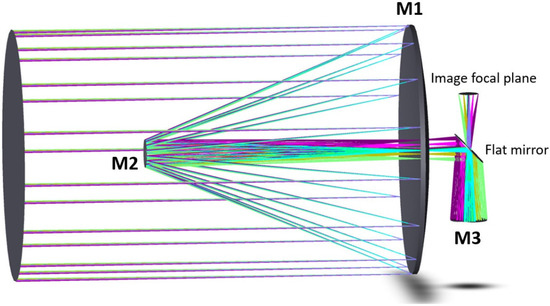
Figure 1.
Optical design of an on-axis 6 m aperture Korsch space telescope. Each field is represented in a different colour.
A total of four mirrors are used for this telescope: three powered mirrors (M1, M2, M3) and a flat mirror. M1 is a paraboloid with conic constant k1 = −0.993; M2 is a hyperboloid with k2 = −1.5001; and M3 is an ellipsoid with k3 = −0.602. These values are shown in Table 3. Their diameters, shown in Table 4, are: 6.00 m, 0.67 m, 0.90 m, and 0.97 m, respectively. The size of the beam at the flat mirror is 318.32 mm × 836.28 mm. The pupil diameter, placed at the flat mirror position, is 121.944 mm.

Table 3.
Conic constants for the three powered mirrors of the telescope.

Table 4.
Diameters of the mirrors of the telescope.
The main characteristics of this telescope layout design are:
- On-axis, which facilitates manufacturing, alignment, and reduction in cost;
- Three-Mirror Anastigmat (TMA) layout, compensating aberrations and providing a diffraction limited optical quality;
- Flat image focal plane;
- The flat mirror used to reduce the overall volume is set at a pupil position, acting as a baffle for stray light and as a Lyott filter to avoid thermal background;
- The rear of the primary mirror acts as an optical bench for payloads;
- The hole of the flat mirror allows the transmission of the central field, which can be used for Active Optics to monitor and correct deformations in the primary mirror in order to guarantee optimum optical performance.
2.3. Optical Performance
The optical quality is diffraction limited for the full field of view and the entire spectral range, as expected from a TMA. This is shown in the spot diagram of Figure 2. This spot diagram is evaluated at the telescope image focal plane for four representative wavelengths (0.5 μm, 0.8 μm, 1.5 μm, and 2.5 μm). Each column corresponds to one wavelength, indicated below each column, and each spot per a wavelength is associated with a field point, with a total of nine angular fields defined covering a field of view of ±0.2 degrees. The circle represents the Airy disc, and as expected, its diameter is a function of the wavelength. In all cases, even for the shortest wavelength of the interval, 0.5 μm, and the largest defined fields, the rays are contained within the Airy disc demonstrating that the optical quality of the telescope is at the diffraction limit.
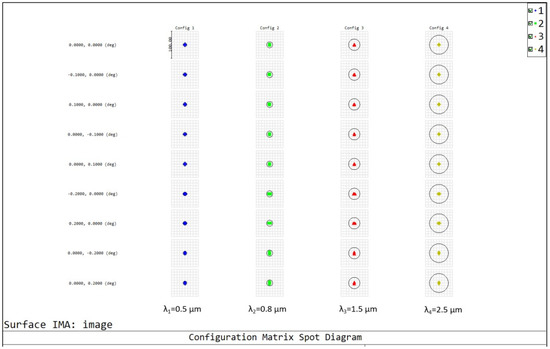
Figure 2.
Diffraction limited optical quality of the proposed space telescope within a spectral range between 0.5 μm and 2.5 μm and for a field of view of ±0.2 degrees.
The contribution of aberrations of each optical component of the telescope is shown in Figure 3. In this diagram, the number of the column corresponds to the row number in the definition of the components in the Zemax OpticStudio data editor. Thus, column number three corresponds to the primary mirror, defined as the STOP; column number four represents the contributions of the secondary mirror; number six represents the flat mirror; number eight is the tertiary mirror; and the final column represented as “SUM” provides the final aberrations at the image focal plane. The largest contribution, coma, is associated with the primary mirror by its parabolic nature and the size of the field of view. This is compensated by the secondary mirror. The initial largest aberrations, coma and spherical, are then compensated. At the image focal plane (tenth column), the small remainder percentage of distortion and field curvature is under the diffraction limit and does not deteriorate the final optical quality. The depth of focus of the telescope evaluated at its image focal plane is presented in Figure 4, where it is shown that the optical quality remains diffraction limited within a depth of focus of ±60 μm.
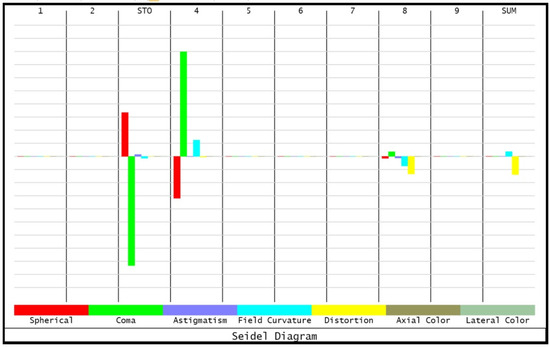
Figure 3.
Seidel diagram showing the contribution of aberrations of each optical component and the final results compensated by the "Three-Mirror Anastigmat" telescope layout.
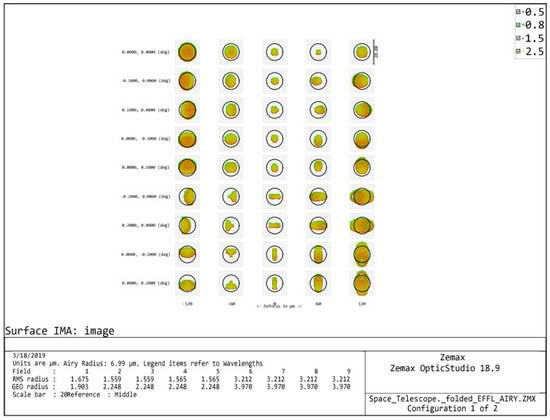
Figure 4.
Depth of focus of the telescope evaluated at its image focal plane. The optical quality remains diffraction limited within a depth of focus of ±60 μm.
The RMS wavefront error presents a uniform response, both across the field and for the defined spectral range. These results are presented in Figure 5 and Figure 6. In both cases, the diffraction limit is represented in black, and it is shown that the values are below this reference.
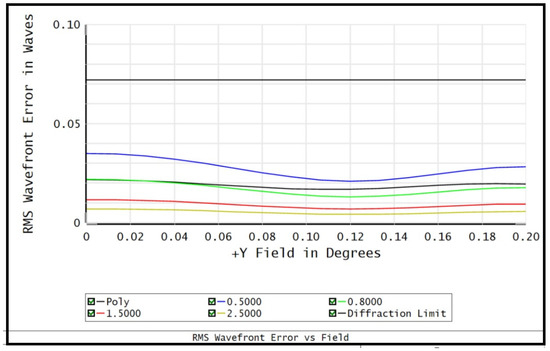
Figure 5.
RMS wavefront error versus field.
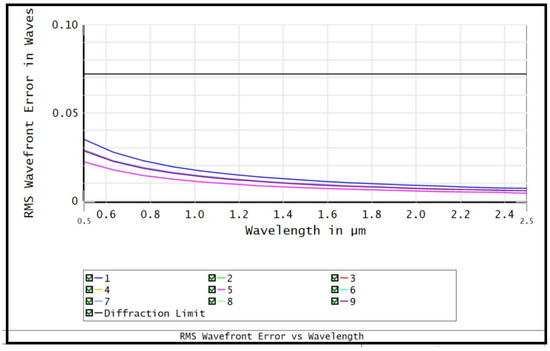
Figure 6.
RMS wavefront error versus wavelength.
The Modulation Transfer Function (MTF) was evaluated. The FFT (Fast Fourier Transform) MTF as a function of the field is shown in Figure 7, Figure 8, Figure 9 and Figure 10.
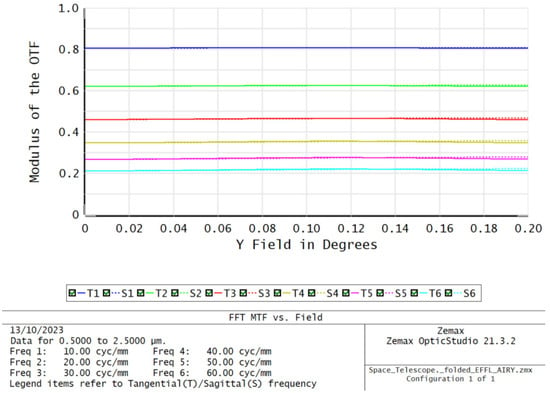
Figure 7.
FFT MTF vs. field along the +Y axis.
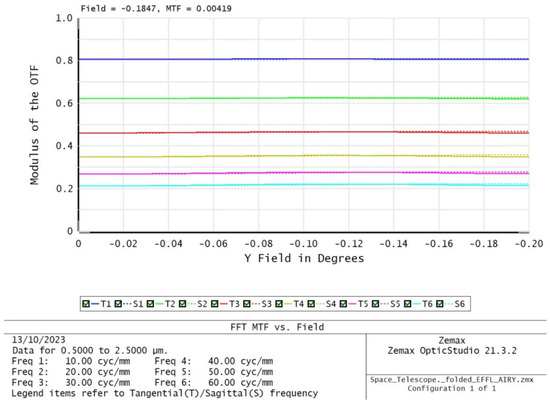
Figure 8.
FFT MTF vs. field along the −Y axis.

Figure 9.
FFT MTF vs. field along the +X axis.

Figure 10.
FFT MTF vs. field along the −X axis.
3. Post-Focus Beam
The proposed Korsch telescope offers a beam with diffraction limited optical quality at its image focal plane. This is ideal for post-focus instrumentation. Depending on the science goals, this post-focus beam can be dedicated to one instrument optimising efficiency or be split providing different foci for multiple payloads.
Telescopes in the Low Earth Orbiter (LEO) are able to obtain images with extremely high resolution. That location, combined with a telescope aperture of six metres, provides a superb spatial resolution. In the proposed layout, the rear side of the primary mirror (M1) acts as an optical bench for the payload. In addition, it blocks stray light, and it can act as a thermal shield. In the presented telescope, a beam-splitter would produce two beams orthogonal to each other, for two instruments that will operate simultaneously, as shown in Figure 11. Since the diameter of the primary mirror is 6 m, this defines the available space without increasing the overall volume. In order to provide a complete analysis of the observed astronomical object, the instruments considered in this case are a multichannel imager and an integral field spectrograph. This would allow observation of the target at high resolution at multiple wavelengths, while an image slicer based integral field spectrograph (IFS) would provide information about the spectrum to analyse the chemical composition.
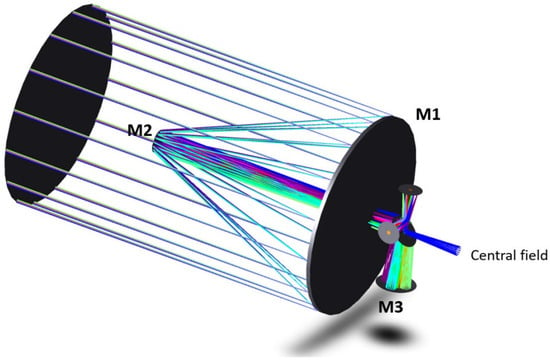
Figure 11.
Two foci for the post-focus instrumentation and central field transmitted through the flat mirror hole. The transmitted beam is proposed to be used for Active Optics corrections. Each field is represented in a different colour.
In Figure 1, a central hole in the flat mirror allows the optical path of the beam reflected in the tertiary mirror. At the same time, the central field is transmitted through this hole, in a direction orthogonal to the science beam direction. This on-axis field could have multiple applications. In this case, we proposed to use it for a wavefront sensor, monitoring the shape of the primary mirror, which can be affected by thermoelastic deformations or stress due to the acceleration of the launch or deployment, and applying Active Optics for correction in order to ensure optimum optical performance. A wide field of view wavefront sensor for Active Optics correction chain for future space telescopes with large monolithic mirrors has been investigated by Durham University, including corrective elements, such as deformable mirrors in the telescope optical components [11]. This research, combined with the presented layout, would offer optimum performance for large aperture space telescopes.
4. Volume
The total length of the proposed telescope is 8.3 m, within the specification. The overall volume is 8.3 m × 6.0 m × 6.0 m, as shown in Figure 12. The focus, placed under the primary mirror (M1), allows an available space for the post-focus instrumentation defined by the size of the primary mirror, 6 m diameter.
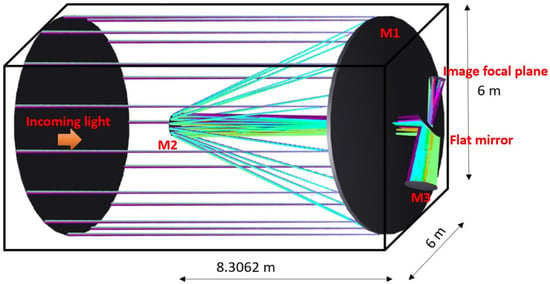
Figure 12.
Overall dimensions of the proposed space telescope: 8.3 m × 6.0 m × 6.0 m. Each field is represented in a different colour.
5. Preliminary Considerations on the Mirror Substrate
Although this manuscript is focused on the optical design, some preliminary considerations were studied for the substrate of a 6 metre primary mirror.
Materials chosen for space have to resist extreme conditions. Before launch, manufacturing, assembly, or inappropriate cleanliness conditions for storage can produce cracks in the material, internal defects, corrosion, or contamination. All these aspects affect the optical performance and the lifetime of the components and, consequently, the mission, which we expect to be at least 10 years after launch. In space, materials are exposed to vacuum. Polymeric materials as well as paints, varnishes, and coatings are considerably sensitive to radiation. Thermal conditions in space are extreme. During orbital phases around the Earth, the temperature variation is 360 °C, between −180 °C and +180 °C. This produces thermal stress in materials. The difference in the coefficient of thermal expansion could cause cracking and lack of adherence, which affects the coating. For telescopes in Low Earth Orbit, as is the case of this telescope, additional damage can be produced by the impact of micrometeoroids, whose collision happens at very high velocity, and orbital debris. Also, telescopes in this orbit are exposed to a flux in atomic oxygen dissociated by radiation, which produces erosion of the materials and coatings. For all these reasons, the selection of the material used for the substrate of the mirrors for a space telescope is crucial. Several important aspects need to be taken into account in the selection process:
- The material shall be lightweight since weight is a very important aspect in space projects.
- The material shall be available for the required aperture size and offer good optical performance.
- The primary mirror shall be stiff enough to maintain an accurate surface figure during launch and for the entire mission cycle on-orbit.
- The material shall be thermally stable.
Two options were evaluated in order to meet all these requirements: Silicon Carbide and Beryllium. Silicon Carbide has been used in many space telescopes, for example, Herschel [12], while Beryllium has been used for the James Webb Space Telescope [1]. Beryllium is a light metal. It is very good at keeping its shape across a range of temperature; it is not magnetic, it is a good conductor of electricity and heat, and it has one of the highest melting points of the light metals. Silicon Carbide is robust, it has high stiffness; it presents high thermal conductivity, low density, low thermal expansion, and excellent environmental stability. Based on their physical properties, both are good candidates; however, Beryllium is highly toxic, and the manufacturing of large aperture mirrors using this material takes a long period of time. This is because precision metallurgy is required to avoid thermal and mechanical hysteresis, and since it is toxic, the machining and polishing processes can be difficult. Thus, Silicon Carbide is the preferred alternative, in particular, a new type called New Technology Silicon Carbide (NTSIC) [13]. NTSIC presents two to three times higher bending strength than the conventional sintered Silicon Carbide. To reduce the weight of the mirrors, especially the primary, a honeycomb structure has been selected, which reduces the weight while keeping the mirror performance.
6. Advantages of an On-Axis Telescope
The primary mirror of the proposed Korsch telescope is parabolic. Although this shape is the most common type of aspherical, using an on-axis parabolic mirror instead of off-axis presents some advantages:
- Manufacturing of on-axis conic mirrors presents less complexity than off-axis conic mirrors. For this reason, there are more alternatives for manufacturers for on-axis mirrors, and the prices for high quality off-axis mirror are significantly higher. This is especially important for telescopes with a large aperture, like the one proposed in this article.
- Metrology of an off-axis conic mirror is also more complicated, and it is required to have some reference to indicate the direction to the centre of the mother conic and the off-axis distance. In addition, off-axis parabolic mirrors are not rotationally symmetric.
- The alignment of an off-axis conic mirror requires significantly more time, and it presents more complexity than the alignment of an on-axis mirror, where the references for integration and for the input and output angles are easier to define. The alignment of an off-axis parabolic mirror is very sensitive, and it requires higher precision in the mirror mount.
These are general characteristics. The proposed telescope design includes some additional references, built into the design, which facilitates the integration and alignment, like the intermediate focus on the centre of M1 and the intermediate pupil position, where the flat mirror is placed and whose dimensions of the central hole match the pupil diameter.
This is an example of how a design decision can simplify the overall system, especially important for space applications, for which we need to avoid risks. The on-axis layout would reduce costs and the time required in different stages of the mission, manufacturing, integration, tests, and calibration.
This layout is at a conceptual design phase. It has not been implemented for a particular space mission yet. The intention of this study is to offer a simpler solution preserving the optical performance, which could benefit some space mission. The proposed layout can be extrapolated to larger apertures and wider fields. Thus, this design is versatile and can be adapted to different requirements.
7. Conclusions
Most of the scientific goals for the next generation of space missions require large apertures, a wide field of view, high resolution, superb optical performance, and high sensitivity within very compact volumes. These challenges focus mainly on the technological side, and different solutions are being investigated. This paper presents a design idea that reduces complexity, cost, and lead time, parameters that are crucial for space, while obtaining the same optical performance achieved by more complex solutions.
A 6 metre aperture Korsch telescope is presented, covering a spectral range between 0.5 μm and 2.5 μm and a field of view of ±0.2 degrees with an optical quality at the diffraction limit. The on-axis layout facilitates manufacturing, metrology, alignment, and tests. This solution can be adapted to larger apertures and wider fields, with the characteristic of a Three-Mirror Anastigmat system, where the aberration contributions are compensated internally. Thus, only three powered mirrors are required to achieve this optical performance. A flat mirror has been added to reduce the total volume. All optical components have been selected to maximise their functionality; for example, the flat mirror is also a pupil mask blocking stray light contribution and it acts as a Lyott filter.
This solution offers an image focal plane with a uniform wavefront error across the field and the defined spectral range. The post-focus beam can be used for one instrument optimising efficiency or split for simultaneous payloads. As a characteristic, it also provides the central field transmitted along a direction orthogonal to that of the science beam, which can be used for multiple applications, for example, for Active Optics correction of the primary mirror to guarantee optimum optical performance.
This is a novel concept that has not been applied yet, but its simplicity and the reduction of complexity that it offers makes it an attractive design to be considered for future missions.
Funding
This research received no external funding.
Data Availability Statement
Data are contained within the article.
Conflicts of Interest
The author declares no conflict of interest.
References
- Gardner, J.P.; Mather, J.C.; Clampin, M.; Doyon, R.; Greenhouse, M.A.; Hammel, H.B.; Hutchings, J.B.; Jakobsen, P.; Lilly, S.J.; Long, K.S.; et al. The James Webb Space Telescope. Space Sci. Rev. 2006, 123, 485–606. [Google Scholar] [CrossRef]
- Endelman, L.L. Hubble space telescope: Mission, design, problems, and solutions. In Proceedings of the High-Speed Photography and Photonics: 21st International Congress, Taejon, Republic of Korea, 29 August–2 September 1994; Volume 2513. [Google Scholar]
- Davilla, P.; Wood, H.J.; Atcheson, P.D.; Saunders, R.; Sullivan, J.; Vaughan, A.H.; Saisse, M. Telescope simulators for the Hubble: An overview of optical designs. Appl. Opt. 1993, 32, 1775–1781. [Google Scholar] [CrossRef] [PubMed]
- Rolt, S.; Calcines, A.; Lomanowski, B.; Bramall, D.; Shaw, B. An efficient stable optical polariser module for calibration of the S4UVN earth observtaion satellite. In Proceedings of the SPIE Astronomical Telescopes and Instrumentation, Edinburgh, UK, 22 July 2016. [Google Scholar]
- Wehr, T.; Kubota, T.; Tzeremes, G.; Wallace, K.; Nakatsuka, H.; Ohno, Y.; Koopman, R.; Rusli, S.; Kikuchi, M.; Eisinger, M.; et al. The EarthCARE mission—Science and system overview. Atmos. Meas. Tech. 2023, 16, 3581–3608. [Google Scholar] [CrossRef]
- Strojnik, M.; Bravo-Medina, B.; Beltran-Gonzalez, A.; Wang, Y. Off-Axis Three-Mirror Optical System Designs: From Cooke’s Triplet to Remote Sensing and Surveying Instruments. Appl. Sci. 2023, 13, 8866. [Google Scholar] [CrossRef]
- Willstrop, R.V. The Mersenne-Schmidt: A three-mirror survey telescope. Montly Not. R. Astron. Soc. 1984, 210, 597–609. [Google Scholar] [CrossRef][Green Version]
- Ralich, A. Reflecting anastigmatic optical systems: A retrospective. In Proceedings of the International Optical Design Conference, Denver, CO, USA, 27 November 2017; Volume 10590. [Google Scholar]
- Lightsey, P.; Atkinson, C.; Clampin, M.; Feinberg, L. James Webb Space Telescope: Large deployable cryogenic telescope in space. Opt. Eng. 2012, 51, 011003. [Google Scholar] [CrossRef]
- Laureijs, R.J.; Duvet, L.; Escudero Sanz, I.; Gondoin, P.; Lumb, D.H.; Oosterbroek, T.; Saavedra Criado, G. The Euclid Mission. In Proceedings of the SPIE Space Telescopes and Instrumentation, San Diego, CA, USA, 29 July 2010; Volume 7731. [Google Scholar]
- Staykov, L.; Morris, T.; Meyers, R.; Calcines, A.; Bitenc, U.; Dunlop, C.; Reeves, A.; Rolt, D.; Human, J.; Baeten, M.; et al. Wide field of view wavefront sensor for active optics correction chain for future space telescopes. In Proceedings of the SPIE 10698, Space Telescopes and Instrumentation 2018: Optical, Infrared, and Millimeter Wave, San Diego, CA, USA, 6 July 2018. [Google Scholar]
- Pilbratt, G.L.; Ridinger, J.R.; Passvogel, T.; Crone, G.; Doyle, D.; Gageur, U.; Heras, A.M.; Jewell, C.; Metcalfe, L.; Ott, S.; et al. Herschel Space Observatory: An ESA facility for far-infrared and submillimetre astonomy. Astron. Astrophys. 2010, 518. [Google Scholar] [CrossRef]
- Suyama, S.; Itoh, Y. NTSIC new technology silicon carbide: Evaluation of microstructure of high-strength reaction-sintered silicon carbide for optical mirror. In Proceedings of the Optical Engineering + Applications, San Diego, CA, USA, 26–27 August 2007; Volume 6666. [Google Scholar]
Disclaimer/Publisher’s Note: The statements, opinions and data contained in all publications are solely those of the individual author(s) and contributor(s) and not of MDPI and/or the editor(s). MDPI and/or the editor(s) disclaim responsibility for any injury to people or property resulting from any ideas, methods, instructions or products referred to in the content. |
© 2023 by the author. Licensee MDPI, Basel, Switzerland. This article is an open access article distributed under the terms and conditions of the Creative Commons Attribution (CC BY) license (https://creativecommons.org/licenses/by/4.0/).